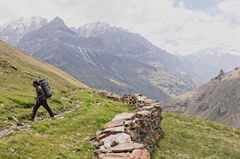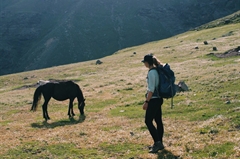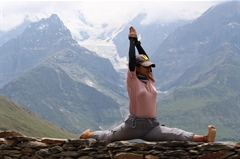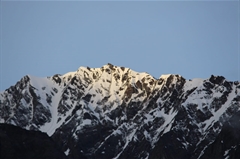Ghepan Ghat Lake Trek
Hidden Gem of Himachal
Available Batches
Brief Description
Brief Itinerary
Detailed Itinerary
Day 1
Manali (2,050M) to Sissu (3,130M)
Distance: 40 kms
Duration: 2 hours
This 40kms drive is fairly smooth and comfortable and goes by in a jiffy. It should take anywhere between 1.5 to 2 hours to cover. Lahaul was previously cut off and secluded which made it hard to access the area. But with the inauguration of the Atal Tunnel, the area remains open to possibilities of exploring new, unexplored trails.
The drive starts along the exuberant Beas River. Within 15 minutes of the drive, we are out of the bustle of the city and onto the Leh-Manali highway which will take us straight to the head of the Atal Tunnel. Going through this 9.02 kms long tunnel, is an experience in itself. The tunnel being at an altitude of 3,048M is the longest highway single-tube tunnel above 10,000 feet. You should reach the head of the tunnel at the mark of an hour and would take close to 10 minutes to cross this all-weather engineering marvel.
Once you exit the tunnel, you will find yourself driving along the murky Chinab River. The roads are characteristic of mountain roads with all its sharp turns on smooth surfaces. Right after we cross the tunnel, we begin to see a stark difference in the landscape. The trees have now shrunk to bushes, the valley is a bit more open and desolate. There are larger expanses of barren mountain-faces and grazing trails with heavily forested mountains now nowhere in sight.
The last half hour of the drive takes us on a kachcha road uphill alongside step-farming lands growing all kinds of vegetation found in the region.
Since it is an easy day with nothing more on the agenda than to reach the trail head of Sissu and set up camp, we leave around the mark of noon so we can reach our destination by lunch.
The first day is reserved for getting acquainted to the altitude, settle into our tents, discuss basic dos and don’t’s and a few mountain ethics. The campsite lies bang opposite the forceful Shitidhar waterfall which seems extremely close but is hours away from the campsite.
Acclimatisation walk for an hour in the evening is mandatory in order to get used to the mountain air and help your body adapt to this new environment.
The night is so eerily silent that you can hear the creaking of your internal body parts as they try to adapt to these new conditions. The night sky from this campsite is nothing short of magical – smoky clouds gently rising up and rolling down mountain tops like they were tucking these high mountains in for the night. The golden glow which stays hanging through the night in the night sky adds a layer of beauty to this love affair. Take some time to admire the night sky and the giant peaks against this night sky as they lie there like ghost mountains in all shades of black and gray, layered one behind the other. If it is a clear night, you might not want to miss heading out of your tent to witness the Milky Way suspended in all its glory held gently by the night sky – all this while the lights from Sissu village below look like descended starlight.
Day 2
Sissu (3,130M) to Camp 1(3,510M)
Distance: 5 kms
Duration: 6 hours
The day starts early with a yoga session and some stretches to awaken our senses. We leave after tea and breakfast for this long but fairly comfortable trek today through massive meadows with a few river crossings. There is a small patch of incline on a rocky terrain after we set off from the campsite. Within the first 15 minutes, we hit the meadows as the valley opens up to an assortment of colours in the form of wildflowers spattered across the bed of the meadows. After a small section of loose rocks which needs to be crossed with caution, it takes less than an hour to reach open grazing lands with heaps of sheep gazing at you with a look of genuine curiosity. The meadows here are packed with flowers spray painted with rich colours ranging from purples, to pinks to a dozen shades of yellow. We now trek along the Sissu naala and hit our first water source at the mark of an hour and a half.
By afternoon, we pick a nice, open spot for lunch. An hour into the climb, after lunch, we hit another section of loose rocks with a very narrow and slippery path which leads straight to a rocky river- crossing section.
Half an hour away from the campsite, we hit a massive obstacle. A large portion of slippery glacier which needs to be traversed with care. This seems especially difficult after having spent the last hour on a narrow trail precariously holding its own on a pile of loose rocks.
After crossing meadows, loose trails, rivers, passing makeshift shepherd homes and abandoned stone huts, the grassy trail leads us straight to camp 1 within 6 hours of starting the day. Camp 1 is bang in the middle of the meadows rich with flora. Look out for strawberries on your way to the camp – tiny red local produce you will find growing all along the trail.
Once at the campsite, we set up our tents and rest for the remainder of the day to regain our strength.
Day 3
Camp 1 (3,510M) to Camp 2 (3,900M)
Distance: 6 kms
Duration: 6 hours
Ghepan Ghat is such a fresh and unknown trail that the campsites do not even have names yet! And today we go from the unnamed Camp 1 to the unnamed Camp 2.
The day starts without a rush. We wake up to the morning sun shining in all its glory, finish tea and breakfast, wrap up the campsite and head on out by 11 AM. The first hour of the climb is perilous – over loose rocks and scree. It is a steep ascend straight up the spine of the mountain. We go off route and descend into the valley to set up Camp 1 due to availability of space and proximity to a water source. This steep descent the previous day is now a steep ascent we must make to connect us back to the original trail. The morning fog makes it almost a dreamlike setting with the clouds waking up the mountain alongside you. The trail today is monopolized by pink with a little of purple and yellow spread out on the floor.
After a small break to eat our packed lunches, we start now on an even trail into the meadows with the entire Pir Panjal range laid out to our left and a milk white water stream flowing alongside. Half an hour into the climb, we hit a precarious section where we cross a gully leading into a brown patch to enter the world of big boulders once again.
Two more hours and we would reach our campsite for the day which is bang in the middle of a grand clearing with welcoming views of mountain ranges all around. Every mountain range has a distinct personality. The peaks laid out in front of you look like disciplinarians – stern and standing confidently without any slump or bend. If they had a face, it would probably be that of an authoritative parent!
There’s a stream of fresh water flowing right by our tents with a spread of pink rising above its edges like it was spilt along the length of the water. The variety of colours on the rocks and boulders in the form of moss is beyond exquisite. Horses by the dozens graze the land around our campsite with a backdrop of black snowy peaks rising up to the skies. The only sound to accompany us on this spectacularly beautiful campsite is the maiming of the cattle that walk comfortably up and down mountain faces.
This campsite is not short of water like the one we left behind – the same gushing water which will make your night a little less silent along with the sound of the howling winds.
Day 4
Camp 2 (3,900M) to Ghepan Ghat (4,146M) and back to Camp 2 (3,900M)
Distance: 5 kms
Duration: 3-4 hours
The day starts as the previous two days, without a rush. The morning view from the campsite proves to be an even bigger delight with the craggy ridges of the mountains providing for pockets for the weary clouds to rest in. It is a beautiful illustration of coexistence and harmony.
It is a relatively short day. Not sure of the exact distance between our camps to the lake, we head out of our tents by 10 for this mystical lake which has only been heard of. The trek to the lake turns out to be breezy and a literal walk in the park. We cover the 2 kms to the lake in close to an hour and the view waiting for you in silence is breathtaking multiplied by all possible hyperboles. As we take a small left from the bouldered meadows we spent the last hour crossing, we are welcomed by this expansive view of mesmerizing colours. Chunk of ice blocks hang casually in the middle of the neon blue glacial lake in the backdrop of massive meadows littered with all sorts of colours. The light mist in the air does its share to add to the mystical beauty of this fold in the mighty high mountains. There is so much to explore across the border of the lake. Take your time soaking in the beauty playing itself out in front of you before you head back out to Camp 2.
Day 5
Camp 2 (3,900M) to Sissu (3,130M)
Distance: 11 kms
Duration: 7 hour
After the breathtaking experience of the brightly-coloured lake and spending two nights on the most beautiful campsite of the trek, today we trace our steps back to Sissu. The trek back down seems like walking on camel humps, with continuous patches of steep ascent and steep descents on narrow trails across the mountain. The trail alternating between vast meadows and massive boulders. The rains tend to make these sections of the mountain, slippery, so it would serve well to exercise caution.
Since it is a long day today, we start early. Our trail back is like a little recap of our climb up to this electric lake. We will pass through meadows, scree sections, boulders and glaciers and water of all colours from electric blue to murky to milk white. The trail for Ghepan Ghat looks like the playing field for the Gods where they created samples of all the beautiful colours they wanted the world to experience. The silver snow, the fluff of the clouds in shades of gray, zinc black mountains providing a surface for the dark cloud shadows to practice their performance. The 3 dozen shades of green, double of those of the browns, a range of flowers with colours from across the colour palette, and the brightly coloured moss sitting merrily on every boulder on the way - this trek is visual poetry in motion.
We reach back to our trail head by close to 2 PM. Two more hours of drive from here to get to Manali. Expect to reach Manali by early evening.
What's Included
- Food as per menu on the trek (Lunch on Day 2 till pack lunch on Day 5)
- Forest Permits/Camping Charges, if any (upto the amount charged for Indian nationals)
- Tents, Sleeping bags, Sleeping mats
- Micro-spikes, Gaiters, and Helmets as required
- Experienced Trek guide, cook, helpers, and porters for carrying common supplies
- Mountaineering course certified Trek Leader with First Aid certification
- Guesthouse/Home stay accommodation in Sissu on Day 1
What's Not Included
- Portage of personal bags during the trek
- Cost of any kind of Travel Insurance.
- Any Expense of personal nature.
- Any Expense not specified in the inclusions list.
- Meals during road journeys
- Transportation from Manali to Sissu and back to Manali.
Are you Eligible for this Adventure?
Resting at an altitude of 4,140M, Ghepan Ghat is a moderate level trek which for its difficulty level is suitable for anyone with some experience of high-altitudes but for its beauty is a beckoning to anyone who loves walking through a land of magic and colour.
BRS Level Required
This makes it mandatory for you to have high-altitude experience of preferably multiple treks marked at level 3 on the BRS. The altitude, the terrain, and the nature of the climb demand a certain level of endurance and a need for you to be aware of how your body reacts to the various features of the high-altitude environment.
If you do not know what level of BRS trek would suit you best, worry not! Fill out this Form:
we will send you a progression chart to help you comfortably get out of your comfort zone in order to level up and ultimately reach your highest potential in the big, bad world of outdoor adventure.
Packing List
This is a list of essential items for individuals doing the trek with Bikat Adventures. This list contains only those items which the participants are required to bring with them. The list excludes those items which are provided by Bikat Adventures on the trek. We have divided the items into five categories. All the items in the list are essential except for those marked as optional.
Trekking Gear
- Ruck sack bag with rain cover. Qty -1
- Day Pack Bag - Recommended for treks with summit day
- Head Torch with spare Batteries. Qty -1
- U V protection sunglasses. Qty -1 Here is how you can choose the best sunglasses for trekking.
- Water Bottles: 2 bottles of 1 liter each
Footwear
- Non-skid, deep treaded, high-ankle trekking shoes Qty -1
- Pair of light weight Slipper/Sandals Qty -1
Clothing
- Quick Dry Warm lower or Track Pants. Qty - 2
- Full sleeves T-shirts/ Sweatshirts. 1 for every 2 days of trekking
- Pair of thick woolen socks. 1 pair for every two days of trekking
- Thermal Body warmer Upper & Lower. Qty-1
- Undergarments. Qty - 1 for every day of trekking
- Warm jacket closed at wrist & neck .Qty-1
- Full sleeves sweater. Qty -1
- Rain wear ( Jacket & Pants ) . Qty-1
- Pair of waterproof, warm gloves. Qty-1
- Woolen cap. Qty-1
- Sun shielding Hat. Qty -1
Toiletries
- Personal toiletries kit (Small Towel, Toilet paper, paper soap, Bar soap, toothbrush, toothpaste, cold cream, etc.)
- Sun screen lotion small pack. Qty -1 Here is your Sun Protection 101 to stay safe in the bright sunny outdoors.
- Lip Balm small pack. Qty-1
Utensils
- Small size, Light weight & Leak proof lunch box. Qty-1
- Plate. Qty- 1
- Spoon.Qty-1
- Tea/Coffee (plastic) Mug.Qty-1
Miscellaneous
- Camera (Optional)
- Carry your medicines in plenty in case you have any specific ailment. Consult your doctor before joining the trek.
- Dry fruits, Nuts, Chocolate bars (Optional)
Frequently Asked Questions
Why Bikat?
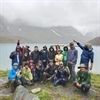

Small Group Size
Our batch sizes are capped at 15 for smaller treks with the trek leader and trekker ratio of 1:8. This ratio, in our years of experience, has proven to deliver the best trekking experience for individuals as well as groups. Capping the size of the group ensures individual attention to each trekker so that no signs of distress or need during the trek go unnoticed. It also helps to form a more cohesive cohort with better group energy which helps define the rhythm and pace of days on the trek. As you go higher up on the BRS scale, since the stakes are higher, expeditions have an even smaller group size with the ratio of expedition leader to climber set at 1:2.


Qualified Trek Leaders
We follow a rigorous regime of hiring and training our experts in the field. Each trek leader is a certified mountaineer with years of experience in the field. In addition to their qualification, they also go through practical and situational training to tackle any and all kinds of sudden conditions that may present themselves on the ground. Being unpredictable is the core nature of the mountains but being ready for any circumstance as best as possible is a controllable asset that we try to nurture. Our field experts are also trained in basic medicine and first-aid response. Watch: Forerunners - The Making of A Trek Leader At Bikat Adventures


Guided Progression
Since Bikat Adventures is a learning-based organization, we help you climb up the ladder of difficulty within the sphere of outdoor adventure systematically. Our on-ground training modules are designed to handhold you through the upskilling process so that you are ready to take on bigger challenges.


Equipment Quality and Check
All the gear used on our treks and expeditions is tried and tested, maintained for good quality, and is overall top-notch in quality and condition. We are continually looking to obtain the best of everything there is in the market so as to ensure optimum safety.


Support Systems
Along with the staff you see on-ground, we have a team of superheroes working in the background to give you the best experience possible. Our background team also comprises local staff from each area who know the region best. Having local support helps with studying the area, pre-planning, execution, and in receiving timely support in case of emergencies in these remote locations.


Communication
Our on-field staff is in constant contact with our teams based in primary locations so as to eliminate any avoidable delay in reaching additional help and support when required. We try to use the best tools for communication available, including satellite phones, in regions where they are not restricted.
What our customers Say
Cancellation Policy
Cash refund
Cancellations up to 60 days prior to departure date
Between 60 days upto 30 days prior to departure date
Between 30 days upto 10 days prior to departure date
Less than 10 days prior to departure date
Voucher refund
Cancellations up to 30 days prior to departure date
Between 30 days upto 15 days prior to departure date
Between 15 days upto 10 days prior to departure date
Less 10 days prior to departure date
- Cash refund is applicable only in case of bookings made without using any promotional offer code or Cancellation Vouchers or Discounts
- This is only a brief of cancellation terms. For finer details please refer Detailed Cancellation Policy.
Blog Posts


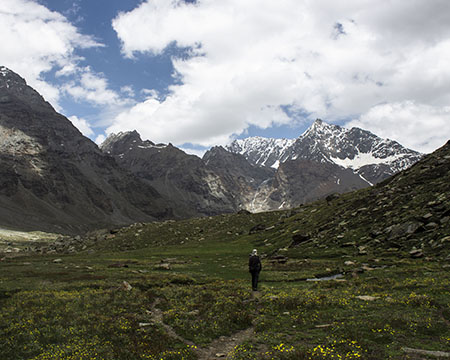

Similar Adventures

Hampta Pass Trek
An Enchanting Cross-Over from Manali to Spiti
Himachal
5 Days
BRS 4
4200 m

Miyar Valley Trek
The Yosemite of the Himalayas
Himachal
8 Days
BRS 4
3990 m

Deo Tibba Base Camp Trek
The Chhota Chandratal Trek
Himachal
6 Days
BRS 4
4480 m





